|
|
Eaton's Christmas Catalogues (Page 2)
<< Page 1
Christmas was a Time for Children
| Community Christmas Trees | Marketing Christmas
| Christmas in the Post-war Period
| It's Never Too Soon to Start Getting
Ready | What to Buy? | The Wishing Book
| Conclusion | Acknowledgements | Further Reading
|
Community Christmas Trees
Rural communities celebrated Christmas through church and large
community
parties, or Christmas Trees, so-called because originally gifts for the
children
were placed on the tree. In the 1930s, Eaton's introduced a
Christmas Tree
Shopping Service that selected gifts based on budget, gender, and age
information
provided. Some children only received gifts at school or community
celebrations,
not at home. In certain cases, teachers purchased gifts through the
Eaton's
catalogues and placed them on the tree to be given out during the
Christmas concert
for children whose families could not afford to buy for their children.
Celebrations also included entertainment such as the school concert, a
special
movie, or theatrical performance (with angels' costumes made from
gauze
ordered by the roll from Eaton's), and refreshments. Community
organizations
raffled items like Eaton Beauty Dolls, for which members had made clothing
and
blankets. Eaton's sold prepackaged stockings and Christmas candy.
| |
 |
|
This Eaton Beauty doll,
given
to Shirley McLouglin of Comox, BC, in 1938, is the only remaining doll
of two pairs given to her mother and aunt at Christmas in the 1910s.
One of the original pair was destroyed by fire so they were given a second
pair the following year. The second fell off the bed in 1936 shattering
its head and the third was sold in the l980s.
|
 |
|
|
Marketing Christmas
Even though modest by today's standards, Eaton's
appreciated
the value of the Christmas market from the beginning. The stores and the
catalogues
complemented each other. Store ads promoted the mail-order service. In
1905,
Eaton's marketing department sponsored the first Santa Claus parade
in
Toronto as a means of encouraging people to spend their Christmas dollars
at
Eaton's. As department stores opened across the country they each
had their
own Toyland at Christmastime. Children were invited to attend the
opening:
It's ready at last! A fairy land to make boys and girls happy,
bright
and wonderful with the loveliest toys you've ever imagined.
You'll
see trains whizzing by like greased lightning, signal lights flashing,
switches
clicking into place. And then there are darling dollies with pretty faces
and
curly hair, their arms outstretched to little mothers. And so many more
jolly
toys and games, we can't begin to tell about them all. Toyland
welcomes
one and all Saturday and every day until Christmas. Come as early as you
like
and stay as long as you like.
|
Christmas in the Post-war Period
| |
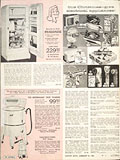 |
|
| |
 Selection
of electrical appliances available through the Eaton's Christmas Catalogue,
1956, p. 184. Selection
of electrical appliances available through the Eaton's Christmas Catalogue,
1956, p. 184.
|
|
| |
|
|
|
After the Second World War, the move to the cities accelerated. The
role of
women in society evolved. Children had fewer responsibilities in the home
and
enjoyed more freedom and attention. The economy diversified. More money
and goods
were available. More goods were purchased rather than made in the home.
The availability
of electricity brought new appliances and forms of entertainment.
| |
 |
|
| |
 Caley's
Christmas Crackers in an Eaton's box. Caley's
Christmas Crackers in an Eaton's box.
|
|
| |
|
|
|
Christmas became more complex. More decorations, more gift giving, more
material
goods, more cards, more baking, more party clothes, more ceremony, more
work
for mother. The season stretched longer into November and people felt it
in their
pocketbooks. The question of giving and pressure to choose the right gift
for
the right person became much more of an issue. The concern that Christmas
had
become too commercial was voiced with increasing frequency in local
newspapers.
|
It's Never Too Soon to Start Getting Ready
Advertisements began to appear early in November, saying
"It's
not too early to think about Christmas shopping." Some objected to
the
early start to the season, feeling that the beginning of November was too
soon
to start thinking about Christmas. By mid-November the tone changed from
congratulating
shoppers on being early to warning them about how quickly the time would
pass.
People used to call to ask the postmaster to open up on Christmas Day
so that
they could pick up a particular parcel or card, but in 1959, the
postmaster was
no longer required to open for a couple of hours on Christmas day. The
post office
itself took out advertisements, saying, "Let's all give Santa
a break
— Mail early for delivery by Christmas."
|
What to Buy?
| |
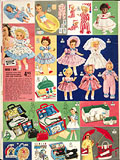 |
|
| |
 Selection
of toys from the Eaton's Christmas Catalogue, 1956, p. 12. Selection
of toys from the Eaton's Christmas Catalogue, 1956, p. 12.
|
|
| |
|
|
|
Most people in the 1950s still tended to buy practical gifts. For
individuals,
there were slippers, homemade food, and hand-knit sweaters. Gifts for the
home
included bedspreads, furniture, and appliances. Electrical gifts were
considered
novelties. Sewing machines were appropriate. Television sets were promoted
as
a family gift. Ties were considered the traditional gift for men. Flowers
were
an option for women. However, the true focus of gift giving was the
children,
with stores promising a broad selection of toys.
| |
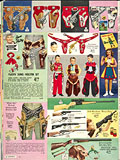 |
|
| |
 Selection
of toys from the Eaton's Christmas Catalogue, 1956, p. 20. Selection
of toys from the Eaton's Christmas Catalogue, 1956, p. 20.
|
|
| |
|
|
|
By the 1950s, there were more options for shopping locally; however,
the Eaton's
catalogues remained an important part of Christmas, particularly for those
living
in rural areas. A man who grew up in Drumheller, Alberta, in the 1950s,
remembers
the excitement of the Christmas catalogue. He considered the catalogue
"a
window to the outside world." As a boy from a relatively poor
family, he
spent a lot of time wishing for things from the catalogue that he would
never
receive.
A woman raising eight young children in the late 1950s remembers,
"We
used the catalogue a lot, especially at Christmas time … it was
almost
worn out at Christmas, because they all looked through it and picked out
things.
They didn't always get what they picked out but they dreamed about
it …"
She also remembered using the Eaton's overseas parcel service to
send goods
that were unavailable in Britain to relatives there after the war.
|
The Wishing Book
| |
 |
|
| |
 Selection
of sports equipment available through the Eaton's Christmas Catalogue,
1956, p. 43. Selection
of sports equipment available through the Eaton's Christmas Catalogue,
1956, p. 43.
|
|
| |
|
|
|
By the 1950s, the fall-and-winter catalogue had grown to over 600
pages, with
about 200 of them in colour. The Christmas catalogue consisted of roughly
200
pages, with nearly half of them in colour. The first 50 pages were
dedicated
to children's goods. Children were more clearly identified as a
distinct
group in the late 1950s, especially in terms of clothing for older
children and
youth. There was more clothing dedicated to specific functions like sports
and
hunting. There were fewer toys available in the "big"
fall-and-winter
catalogue because they were concentrated in the Christmas catalogue, along
with
sports equipment, art and craft supplies, and books.
| |
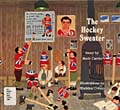 |
|
| |
 Cover from The Hockey Sweater by Roch Carrier,
illustrations
by Sheldon Cohen, Montréal: Tundra Books, 1984. Cover from The Hockey Sweater by Roch Carrier,
illustrations
by Sheldon Cohen, Montréal: Tundra Books, 1984.
|
|
| |
|
|
|
Popular toys included dolls, trains, toys that mimicked adult
activities,
chemistry sets, Meccano, building blocks, Robin Hood, Zorro and cowboys
and Indians,
space toys, guns, armies, arcade-type shooting games, hockey, pool,
bowling,
and board games. National Hockey League sweaters for the Montréal
Canadiens
and the Toronto Maple Leafs were available and longed for by many boys as
later
described in Roch Carrier's popular story, The Hockey
Sweater,
in which Eaton's sends the wrong sweater. The number of musical
instruments
in the catalogues declined as the number of pages dedicated to electrical
goods,
radios, and televisions increased.
| |
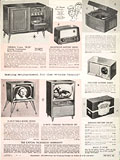 |
|
| |
 Selection
of radios, record players, and televisions available through the Eaton's
Christmas Catalogue, 1956, p. 183. Selection
of radios, record players, and televisions available through the Eaton's
Christmas Catalogue, 1956, p. 183.
|
|
| |
|
|
|
The image of Santa Claus became a significant feature in advertising
and community
celebrations. Letters to Santa were sent through the mail, dropped off at
local
stores, or published in newspapers. Most children only asked for one or
two things
and often wrote requesting presents for their younger siblings. Favourite
requests
included trucks, dolls, electric trains, dishes, colouring books, puzzles,
nurses'
and doctors' kits, skates, hockey equipment, brooms and mops, baking
sets,
books, telephones, televisions, musical instruments, guns, and watches.
Some
requested pets such as dogs and even a monkey.
|
Conclusion
| |
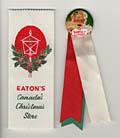 |
|
| |
 Ribbons
and buttons promoting Eaton's as Canada's Christmas Store. Ribbons
and buttons promoting Eaton's as Canada's Christmas Store.
|
|
| |
|
|
|
The Eaton's catalogue was a key part of Christmases past. In the
early
20th century, the catalogue was an important source for a variety of goods
(and
just as often dreams) that were unavailable locally in rural Canada. By
the 1950s,
there were more local stores and a broader assortment of goods, but
Eaton's
remained important in people's minds and shopping habits —
particularly
those who lived in remote areas.
Acknowledgements
This segment is primarily based upon
research reports
conducted for the Red Deer and District Museum in Alberta and for the
Fraser-Fort
George Museum in Prince George.
|
|
|
Further Reading
Cole, Catherine C. "Childhood in Prince George,
1910-1960."
Unpublished research report prepared for the Fraser-Fort George
Museum,
Prince George, BC, March 2002.
Cole, Catherine C. "The Wishing Book: Dreaming of Christmas in
Central
Alberta through the Eaton's Catalogues 1925-1929,
1955-1959."
Unpublished research report including oral histories conducted by Judy
Larmour
for the Red Deer and District Museum, October 2000.
|
| |
|
|